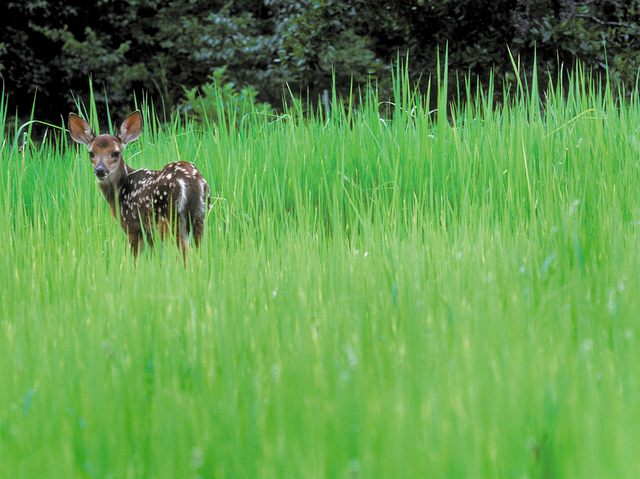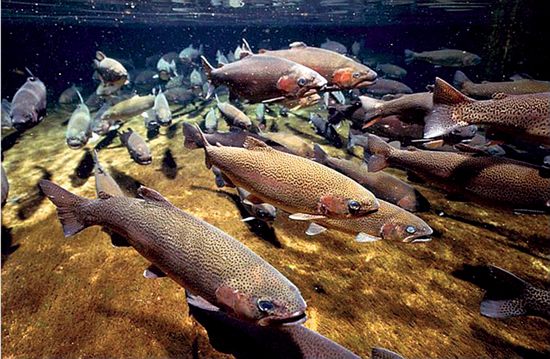How Radioactive Animals Become Tools, Pests and Political Statements
Far from Chernobyl, turtles, rabbits and cows make nuclear cleanups an educational mess.

A deer hangs out at the Savannah River Site nuclear reservation. (Photo: Savannah River Site/CC BY 2.0)
In the late 1970s, a worker at South Carolina’s Savannah River Site nuclear reservation peered into a seepage basin and spotted a small, out-of-place turtle. Scooping it out of the nuclear waste, the worker toted his new charge to a nearby ecology lab, where he figured they’d know what to do with it.
As he walked in the lab door, a radioactivity counter began beeping. The lab technician tested the mud on the worker’s shoes, figuring he’d tracked in some of the site’s contaminated muck. When the shoes came up clear, the confused technician tested further. After a few more swipes, the culprit emerged: It was the turtle.
Though this was the first radioactive turtle found at the Savannah River Site, it was far from an anomaly—there or elsewhere. Across the world, such creatures scurry, swim and fly among us. Unlike popular representations might lead us believe, most of them lack grotesque deformities, special abilities, or weird proclivities for pizza. Instead, like that turtle, many of them are totally healthy and happy—living relatively normal lives and, unless we try to eat them, posing little direct threat to humans.
But that hasn’t stopped us from trying to ascribe meaning to these nuclear animals. Over the decades, people have come up with numerous ways to relate to them: as public health threats, as research tools, or even as political statements. What lessons, if any, should we take from the turtles?

Salmon spawning near a former reactor site at Washington’s Hanford nuclear reservation. (Photo: US Department of Energy/Public Domain)
According to Dr. Andrew Karam, a nuclear safety consultant, most people interested in radiation and living things focus on two interconnected concerns: “The effects of the radiation on the organisms, and the effects of the organisms on the radiation.” Although scientists argue about exactly how exposure manifests in different species, thanks to a 1996 UN report, we have a pretty good idea of roughly what types are most vulnerable. “In general, the more sophisticated the organism, the more sensitive it is,” says Karam. Mammals and birds are easily affected by radiation, while fish and insects show fewer signs. The same goes for plants. “A colleague told me that, after Chernobyl, he could tell where radiation doses were dangerously high because that’s where the pines had suffered or died,” says Karam. For moss and lichens, though, the exposure barely registered.
When it comes to radioactive animals, Chernobyl’s wildlife gets a lot of the limelight. And with good reason—in the 30 years since the reactor disaster mandated a mass human exodus, the Chernobyl Exclusion Zone has become a kind of ad hoc wildlife refuge. As Henry Shukman writes in Outside, the area has become “a giant radiation lab,” where creatures live with “a preindustrial number of humans and a postapocalyptic amount of radioactive strontium and cesium.” Former streets are now tangles of dense forest, trafficked only by birds and butterflies.Wolves hunt elk near abandoned buildings. Large mammals have moved in, in numbers unseen since the 19th century. Scientists flock there, too, trying to see whether the benefits of our immediate absence outweigh the harms of our toxic legacy.
But Chernobyl’s creatures aren’t the only irradiated ones on the planet, and their extreme situation is far from the lone option. Thanks to energy facilities and weapons manufacturers, creatures across the globe show heightened radioactivity counts. This leads to Karam’s second area of concern—which is, for nearby humans at least, much more immediate. Even as nuclear facilities count on well-built infrastructure to protect their surroundings, animals and plants can act like living leaks, absorbing high levels of radiation and then bringing it into the neighborhood.
Environmental contamination is probably the biggest threat to humans from irradiated animals, but that threat differs greatly according to species. Small animals with limited home ranges and zero burrowing instincts “are pretty innocuous,” says Karam, but fast-moving, hard-digging creatures can scatter contaminants far and wide. This is a particular problem at Washington State’s Hanford nuclear reservation, a former plutonium factory currently undergoing a multi-decade cleanup that has been repeatedly critter-compromised. In 1959, radioactive rabbits strewed high-cesium droppings across four square miles of the reserve; in 1998, “hot” fruit flies from the plant hitched a ride to a nearby dump, necessitating a 210-ton garbage recall. More recently, a sole contaminated mouse spurred a 60-trap hunt. (Employees have to keep a lookout for plant runaways, too—tumbleweeds have been known to suck contaminants up through their taproots and roll helter-skelter into the wilderness.)
At the Savannah River Site, scientists treat radioactive critters in a slightly different way, using them to figure out where waste might be coming from. The site holds decades’ worth of sludge in seepage bins, which occasionally leak into soil and ponds. Scientists will catch nearby turtles and alligators and test them; if a reptile beeps, they’ll know that its home zone needs more help. Then, they’ll toss it into a fenced-in pond to keep it from spreading the contaminant further. Ordinary citizens get involved, too: after the annual deer hunt, everyone sends their venison in for testing, and cuts out any radiation-heavy chunks.
For animals that are raised solely for food, radioactivity can be a death sentence—once meat or milk outstrips government radiation limits, it’s considered unsafe for human consumption, and therefore unsellable. After the 2011 Fukushima disaster, the Japanese government issued a kill order for the area’s thousands of no-longer-edible cattle, calling them “walking accident debris.” In protest, a rancher named Masami Yoshizawa moved back to his abandoned farm and took in about 300 irradiated cow refugees, feeding and housing them in defiance of what he saw as government apathy. “I decided to become the resistance,” he told the New York Times in 2014.
Radiation may not give a turtle or a rabbit true superpowers, but it does make them, to borrow from Yoshizawa, scaly, fluffy parts of the resistance. When the U.S. government has to spend hundreds of thousands of dollars helicopter-scanning for rabbit droppings, it’s hard not to take that as some kind of statement—about nature, about human priorities, about past decisions’ long chain of unpredictable consequences. Radiation might be invisible, but, as Karam says, “you can’t get away from it.” Especially not when it poops in your backyard.
Naturecultures is a weekly column that explores the changing relationships between humanity and wilder things. Have something you want covered (or uncovered)? Send tips to [email protected].















Follow us on Twitter to get the latest on the world's hidden wonders.
Like us on Facebook to get the latest on the world's hidden wonders.
Follow us on Twitter Like us on Facebook